Justin Trudeau faces a summer marked by discontent: WSJ
According to a recent poll by Ottawa-based Abacus Data, half of Canadians are calling for a new government, while only 19% still support Trudeau.
According to a recent poll by Ottawa-based Abacus Data, half of Canadians are calling for a new government, while only 19% still support Trudeau.
From August 3 to 7, 2023, Abacus Data conducted a national survey of 1,650 Canadians (18+) to assess their perceptions of sustainable living.
In this survey, we examined the actions Canadians presently engage in (or would consider taking) to help address climate change, along with the perceived obstacles linked with adopting more sustainable behaviours. The results underscore a contrast between Canadians’ inclination to tackle climate change in their personal and professional spheres and the perceived difficulties that hinder their capacity to convert this intention into action.
When examining efforts taken to help address climate change, a considerable number of Canadians are actively engaging in impactful daily behaviors. Notably, 81% partake in recycling and composting, 72% practice energy-saving practices like turning off lights, 59% reduce water usage, and 57% have integrated energy-efficient appliances and LED lighting into their homes. Additionally, many Canadians expressed their readiness to support sustainable and eco-conscious initiatives: 58% would actively support businesses with such principles, while another 58% would encourage the adoption of green initiatives at work. Furthermore, 64% would embrace renewable energy sources, and 52% would consider purchasing an electric vehicle.
These findings underscore that a significant segment of Canadians have already engaged in everyday actions that contribute to addressing climate change, and moreover, they display a keen willingness to undertake more substantial personal commitments towards this cause.

Despite a willingness to take significant steps toward mitigating climate change, Canadians identified multiple obstacles impeding their action. Foremost among these barriers is financial limitations, a concern shared by 53%, followed by a perceived lack of access to reasonably priced products, cited by 50%. Beyond these, challenges arise from limited awareness of sustainable lifestyle choices (30%) and time constraints (27%). Collectively, these findings underscore the need to enlighten Canadians about the accessibility and affordability of sustainable living options. Moreover, disseminating information about these products and services holds the potential to amplify awareness and, consequentially, foster greater adoption.

As emphasized, financial constraints stand out as the primary barrier to leading a more sustainable way of life. This is starkly highlighted by the fact that 32% of Canadians are uncertain about the relative cost of a climate-friendly lifestyle, while 31% perceive adopting such a lifestyle as more expensive. In essence, these findings accentuate a lack of awareness among Canadians regarding the economic advantages tied to embracing a climate-friendly lifestyle. This situation presents organizations with a compelling opening to educate Canadians about the financial gains associated with choosing eco-friendly products and services, especially for those choices that do not require a prohibitive investment. Specifically, imparting information about the long-term financial savings potential could serve as a pivotal incentive for greater adoption.

According to Eddie Sheppard: In the realm of addressing climate change, many Canadians demonstrate a commendable commitment to sustainable living through a range of impactful daily behaviors as well as a willingness to embrace weightier undertakings, including supporting eco-conscious businesses, advocating for green initiatives at work, adopting renewable energy sources, and considering electric vehicles.
However, amidst this strong willingness to act, Canadians perceive significant obstacles to a greener lifestyle. Chief among these barriers are financial limitations, a concern shared by 53%. Perceived financial barriers may be holding people back, especially if there is a large up-front investment required to adopt greener approaches. In line with this, 31% perceive sustainability as a costlier path, while 32% remain uncertain about its economic implications. This knowledge gap creates an ideal opportunity for organizations to highlight the financial benefits tied to adopting eco-friendly choices.
Overall, this survey underscores a strong willingness to combat climate change, alongside perceived hurdles like financial limitations and knowledge gaps. Despite these challenges, the prevalent openness to adopting climate-friendly lifestyle choices offers a promising avenue for education and advocacy. By promoting awareness about the accessibility, affordability, and/or long-term financial benefits of sustainable living, organizations can equip Canadians with the information and confidence needed to make lifestyle decisions that drive meaningful change.
The survey was conducted with 1,650 Canadian adults from August 3 to 7, 2023. A random sample of panelists were invited to complete the survey from a set of partner panels based on the Lucid exchange platform. These partners are typically double opt-in survey panels, blended to manage out potential skews in the data from a single source.
The margin of error for a comparable probability-based random sample of the same size is +/- 2.4%, 19 times out of 20.
The data were weighted according to census data to ensure that the sample matched Canada’s population according to age, gender, educational attainment, and region.
This survey was paid for by Abacus Data Inc.
Abacus Data follows the CRIC Public Opinion Research Standards and Disclosure Requirements that can be found here: https://canadianresearchinsightscouncil.ca/standards/
We are the only research and strategy firm that helps organizations respond to the disruptive risks and opportunities in a world where demographics and technology are changing more quickly than ever.
We are an innovative, fast-growing public opinion and marketing research consultancy. We use the latest technology, sound science, and deep experience to generate top-flight research-based advice to our clients. We offer global research capacity with a strong focus on customer service, attention to detail, and exceptional value.
We were one of the most accurate pollsters conducting research during the 2021 Canadian election following up on our outstanding record in 2019.
Contact us with any questions
Find out more about how we can help your organization by downloading our corporate profile and service offering.

Experienced researcher Eddie Sheppard joins Abacus Data where he will help grow the firm’s consumer research practice and help lead the analysis and insights team.
“We are excited to be welcome Eddie to our team,” said Chief Executive and Chairman David Coletto. “Eddie brings his over 15 years of experience in market research to our growing team of experts and consultants.”
Eddie has built a strong reputation for delivering strategic solutions to clients through the integration of research, facilitation, and analytics. His expertise spans strategic planning, public policy, and consultation for local to international clients across sectors like government, residential development, transportation, tourism, education, and finance (among others). Prior to joining Abacus, Eddie refined his skills working with some of the largest market research firms in Canada.
He holds a PhD in Social Psychology from the University of Calgary where he also taught as an Adjunct Assistant Professor for nearly a decade. His academic background provides him with a deeper understanding of human behaviour and decision-making processes, further strengthening his ability to provide valuable insights to his clients.
Celebrating its 13th anniversary this year, Abacus Data quickly established itself as a leader in public opinion and market research. Working with some of North America’s leading brands, associations, and public sector organizations, Abacus Data helps clients make better decisions through high-quality data, insights, and strategic advice.
“Eddie will build on an already roster of highly skilled and experienced researchers,” added Coletto. “I’m excited to have him join our team and expand our consumer research practice with his breadth of experience in reputation and brand studies.”
Eddie will directly contribute to Abacus Data’s growing public affairs and consumer research practice working with partners in all three levels of government as well as public sector organizations. In addition to this, Eddie will serve as the research lead in the GTA and Southwestern Ontario, providing clients with high-quality research services from custom surveys, to qualitative research, to advanced analytics and data tracking.
“Over the years, I have watched as the team at Abacus, led by David Coletto, approached research in a way that allowed them to build compelling stories from data to highlight how Canadians truly think, feel, and behave,” said Sheppard. “I was also continuously impressed by their consistent record of accuracy in their public election polling. I firmly believe that the research conducted by Abacus is a true reflection of their quality and underscores the team’s collective strengths. The remarkable growth of Abacus and the exceptional research professionals on the team have truly impressed me.”
“My decision to join Abacus stems from my belief in the potential that it holds – a place where I can not only create a substantial impact but also play a pivotal role in helping to shape the company’s trajectory. For me, it was about being part of a vibrant and dynamic culture, where every step forward is a testament to our shared dedication and vision.”
From July 20 to 25, 2023, Abacus Data conducted a national survey of 2,486 adults exploring several topics related to Canadian politics and current events as part of our regular national omnibus surveys.
In this survey, we explored Canadian views and perceptions on inflation and interest rates. The results reflect a complex interplay of understanding, beliefs, perceptions, and ideological biases, demonstrating that the public’s opinion is nuanced and multifaceted.
Understanding of Interest Rates and Government Influence
A key finding of this survey shows the mixed understanding of the mechanisms and influences behind interest rates. Around 4 in 10 Canadians believe that the federal government wields some influence on these rates. While some understanding of the Bank of Canada’s role is apparent, given that 41% believe it bears sole responsibility for setting rates, a large proportion (36%) think it works under directives from the federal government. This demonstrates a lack of clarity in understanding the independent role of the Bank of Canada in setting interest rates.

Perceived Necessity of Interest Rate Increases
As to the question of necessity, Canadians are divided on whether they believe recent interest rate hikes are required to curb inflation. The fact that 44% think it’s probably or definitely not necessary suggests skepticism about the Bank of Canada’s actions. This skepticism could be stemming from a lack of understanding of the intricacies of economic policy or dissatisfaction with the current economic climate. Furthermore, with more than a third of Liberal Party voters deeming interest rate hikes unnecessary for curbing inflation, it is clear this could be a driver in the government’s declining poll numbers.


Acceptability of Economic Slowdown for Reducing Inflation
The acceptance of a possible economic slowdown or recession as a means to combat inflation is a contentious issue among Canadians. Only 34% find this strategy acceptable, while 40% deem it unacceptable. This indicates that Canadians are not ready to accept significant economic sacrifices for inflation control. The NDP voter group’s particular reluctance underlines how these perspectives can differ along partisan lines and presents an opportunity for the NDP.
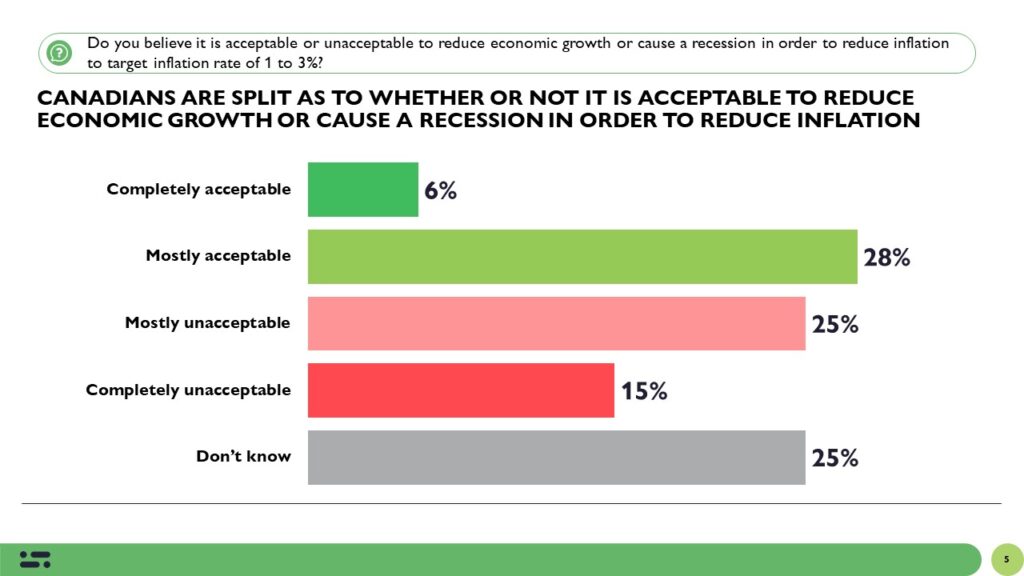
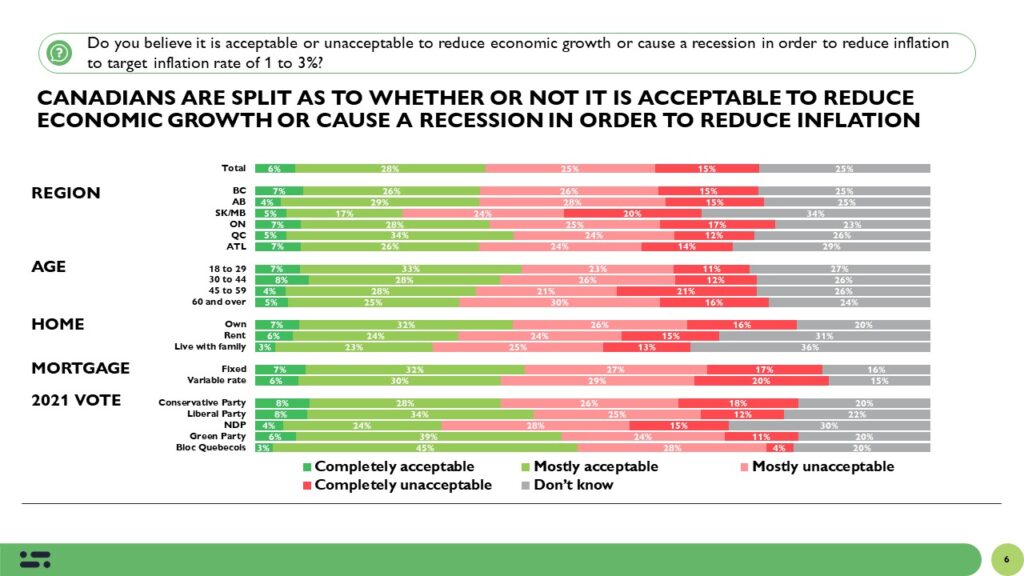
Perceived Causes of Inflation
Canadians attribute the causes of inflation mainly to ‘greedflation’ and government spending. They also demonstrate a reasonable understanding of global supply chain issues contributing to inflation. This points towards a more nuanced understanding of economic dynamics and factors driving inflation, showing that Canadians are not solely blaming local factors but are also aware of international factors. However, the extent to which they attribute inflation to the federal carbon tax, particularly among Conservative voters, indicates how politicized the carbon price has become.
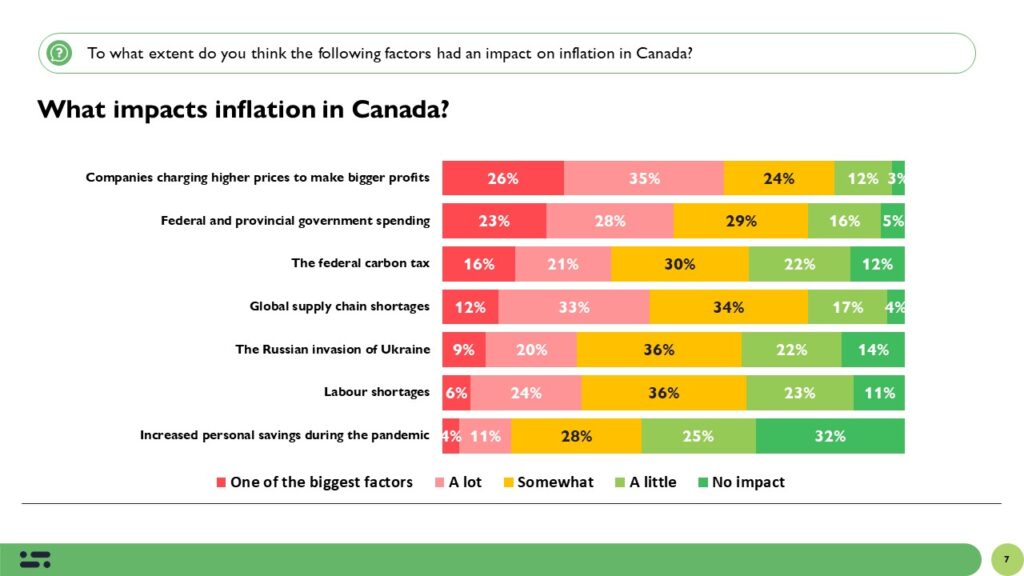

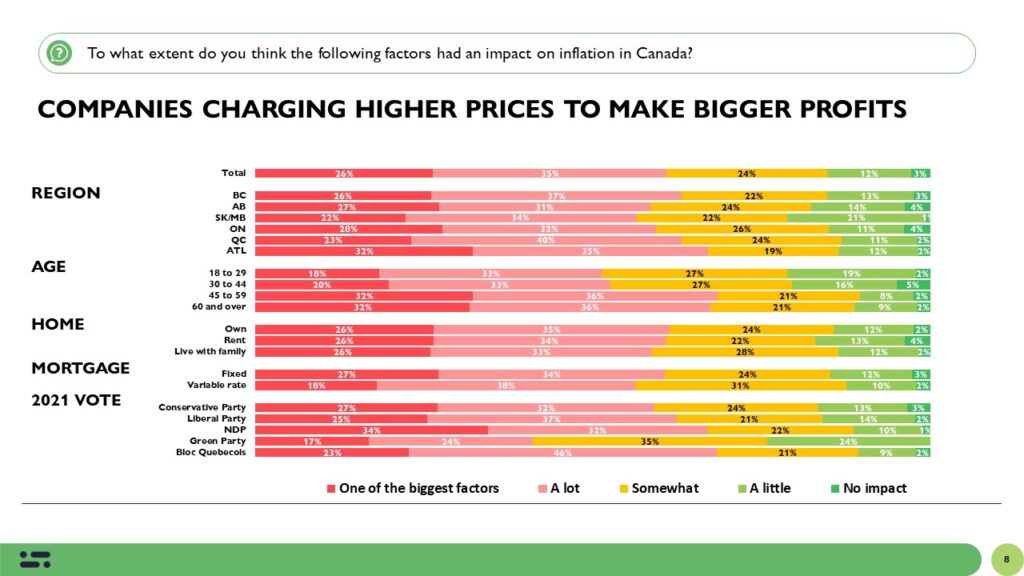
Perceptions of Canada’s Inflation Rate Relative to G7
The fact that only 13% of Canadians think that Canada’s inflation is lower than other parts of the world, despite it being the lowest in the G7, underscores a disconnect between perceptions and reality. It suggests a need for better communication from the government on this matter. If a majority, including 40% of Liberal voters, erroneously think that Canada’s inflation is higher, it points to a significant communications challenge for the Liberal government and one it needs to address if it’s narrative around economic management and the cost of living is going to connect.
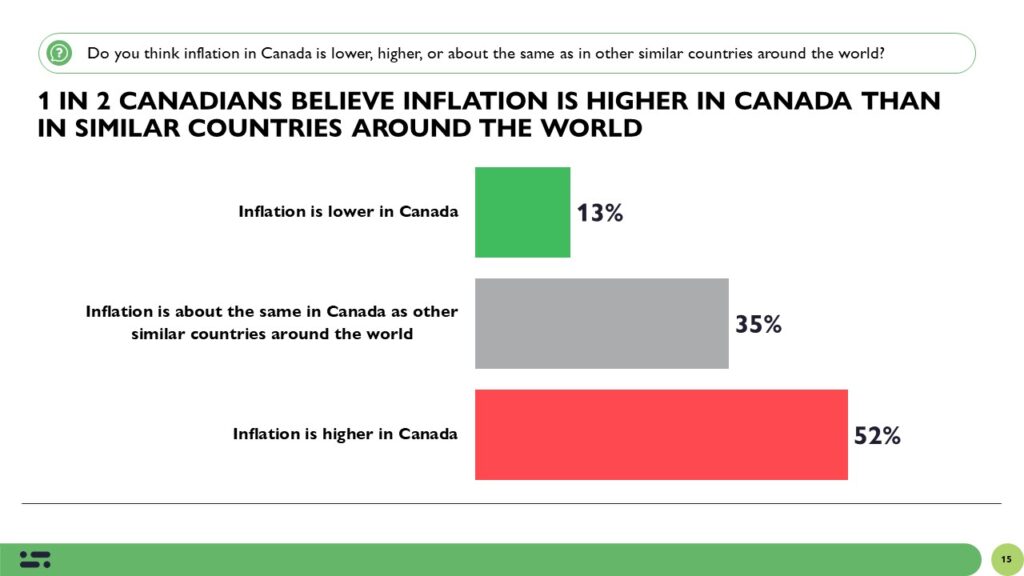
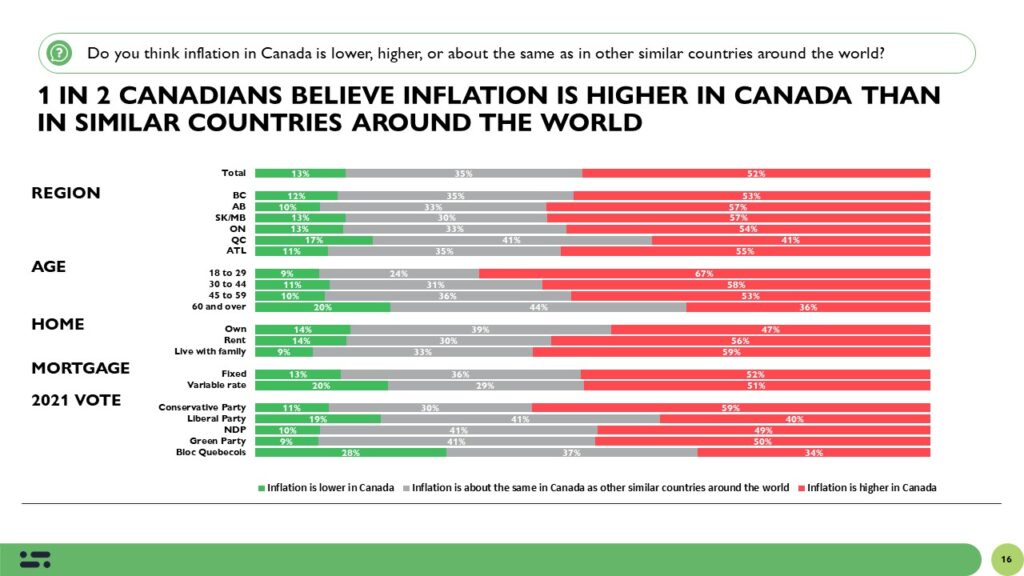
Impact of Rising Interest Rates on Housing
A majority of Canadians (82%) believe that rising interest rates are contributing to more expensive housing. This perception highlights the complexity and depth of public opinion about inflation and interest rates, suggesting that Canadians see the issues through the lens of personal impact, like housing affordability.

The Upshot
These survey results hold significant political implications. For the incumbent Liberals, the data highlights a need for enhanced communication to correct the public’s understanding and perception of inflation and interest rates. The party faces the challenge of managing its image regarding its influence over the Bank of Canada, and there is a crucial need to clarify the distinction in roles and independence. The misperceptions about Canada’s inflation rate compared to the global landscape indicate an opportunity for the Liberals to demonstrate their economic management skills and challenge the narrative.
However, the data also presents opportunities for opposition parties. The Conservatives, for instance, have focused on the discontent regarding the federal carbon tax general and linking it to inflation will only help to animate its base. They could also tap into the belief that rising interest rates contribute to expensive housing, a key issue for many Canadians. For the NDP, the widespread unacceptability of causing an economic slowdown to reduce inflation might be a point of commonality with their voters that they can leverage.
Overall, this survey paints a picture of a Canadian public that holds complex, sometimes contradictory views on inflation and interest rates. While there is a general understanding of some economic principles, there’s also clear confusion and political polarization. The findings suggest that the government, the Bank of Canada, and opposition parties all have significant roles to play in shaping, influencing, and responding to these public perceptions.
Inflation has a tendency to kill governments. Because of confusion over what is causing it and who is responsible for taming it, governments are often blamed for both.
METHODOLOGY
The survey was conducted with 2,486 Canadian adults from July 20 to 25, 2023. A random sample of panelists were invited to complete the survey from a set of partner panels based on the Lucid exchange platform. These partners are typically double opt-in survey panels, blended to manage out potential skews in the data from a single source.
The margin of error for a comparable probability-based random sample of the same size is +/- 2.0%, 19 times out of 20.
The data were weighted according to census data to ensure that the sample matched Canada’s population according to age, gender, educational attainment, and region. Totals may not add up to 100 due to rounding.
This survey was paid for by Abacus Data Inc.
Abacus Data follows the CRIC Public Opinion Research Standards and Disclosure Requirements that can be found here: https://canadianresearchinsightscouncil.ca/standards/
ABOUT ABACUS DATA
We are the only research and strategy firm that helps organizations respond to the disruptive risks and opportunities in a world where demographics and technology are changing more quickly than ever.
We are an innovative, fast-growing public opinion and marketing research consultancy. We use the latest technology, sound science, and deep experience to generate top-flight research-based advice to our clients. We offer global research capacity with a strong focus on customer service, attention to detail, and exceptional value.
We were one of the most accurate pollsters conducting research during the 2021 Canadian election following up on our outstanding record in 2019.
Contact us with any questions.
Find out more about how we can help your organization by downloading our corporate profile and service offering.
From July 20 to 25, 2023, Abacus Data conducted a survey of 1,000 Ontario adults updating our tracking of views and opinions about provincial politics in Ontario.
As voters in Ottawa and Scarborough head to the polls tomorrow in two provincial by-elections, Doug Ford and the PCs hold a commanding lead province-wide.
41% of committed voters would vote for the PCs with the Liberals (24%) and NDP (23%) statistically tied for second. The PCs lead in all regions of the province and across demographic groups.
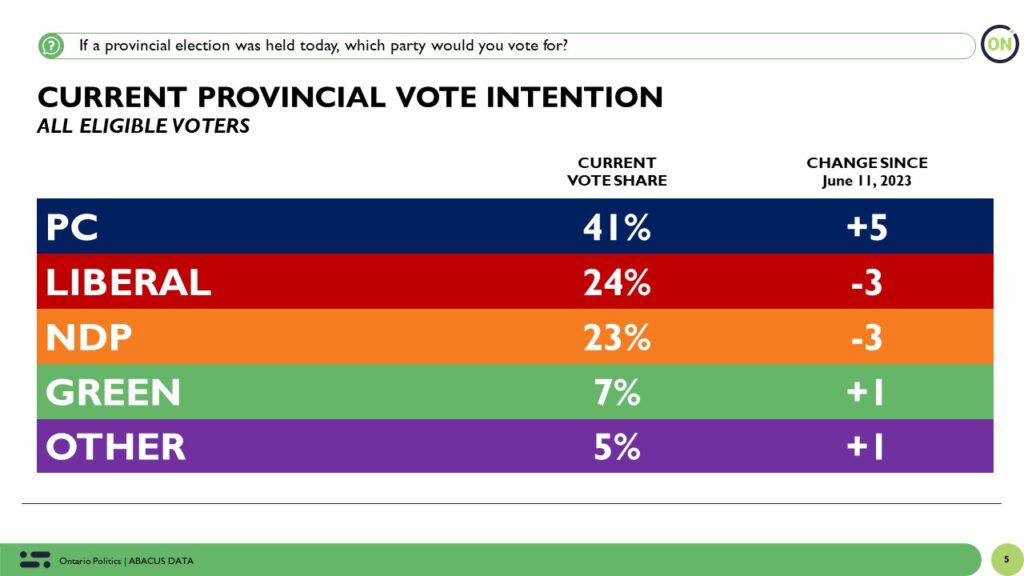

Overall, 35% of residents approve of the job performance of Doug Ford and the provincial government while 43% disapprove. Among 2022 PC voters, 69% approve while 8% disapprove.
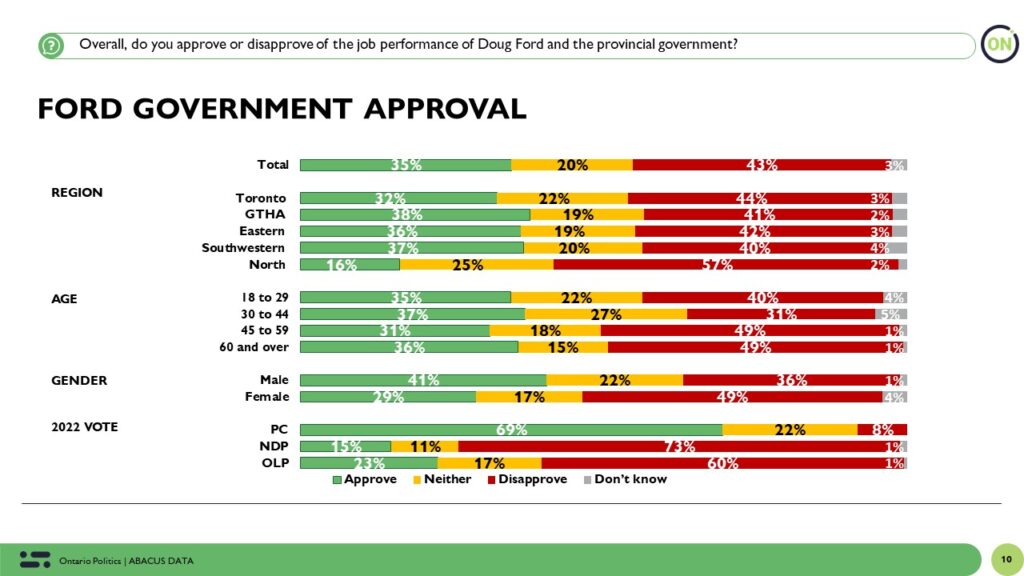
In this survey, we asked several new questions to gauge how Ontarians feel the provincial government is doing in several policy areas.
First, we asked people whether they feel the provincial government is focused too much, about the right amount, or not focused enough on several policy areas. A clear majority feel the provincial government is not focused enough on housing, affordability, and healthcare.
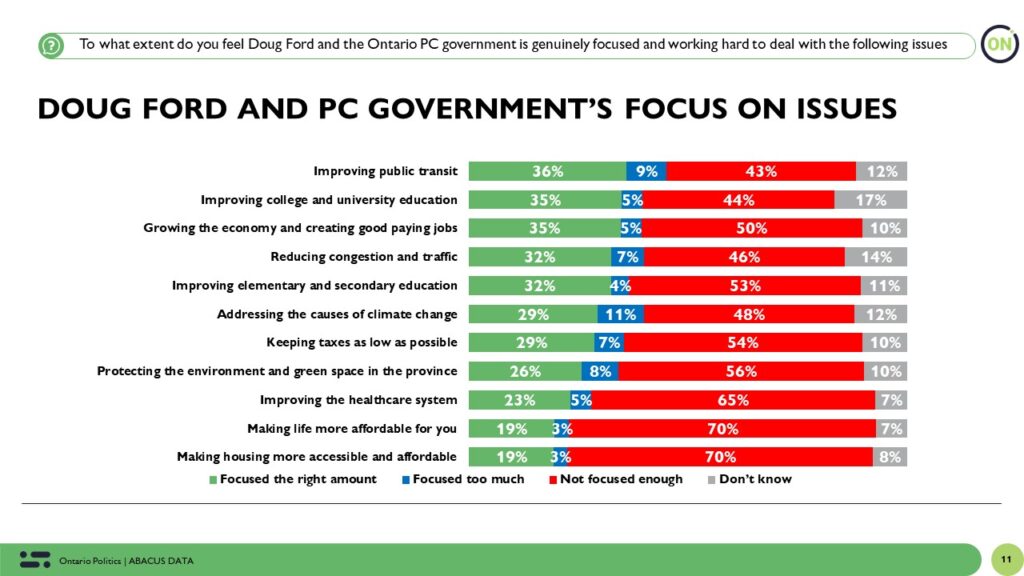
When we ask people to rate the provincial government’s performance in the same areas, on a scale from 0 to 10, the government’s performance on housing, affordability, and healthcare get the lowest overall scores. In fact, there isn’t an area where the government is perceived to be performing well but it gets higher grades for its handling of growing the economy, improving transit, and on education.
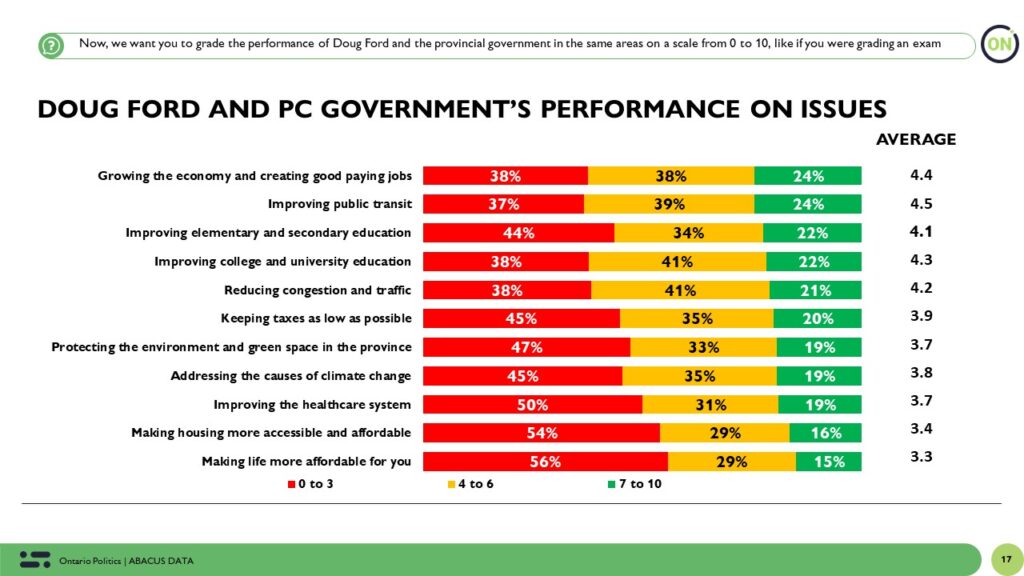
Among PC voters in 2022, housing and affordability are two areas where the government faces some vulnerability. About 1 in 3 past PC voters give the government poor grades on its handling of those issues.

Finally, in this survey, because the government and the premier has faced criticism over some of the decisions it has made in recent months, we asked the following question:
When it comes to decisions that Doug Ford and his government have made, which of the following comes closest to your view?
Overall, 54% think Doug Ford and the government have made decision primarily about what’s in the best interest of his friends and supporters. 27% say decisions have been made primarily about what’s in the best interest of people in the province. The remaining 19% were unsure.

Among past PC voters, 52% think the government has made decision in the public’s interest, but 1 in 3 say it has made them for its supporters and friends.
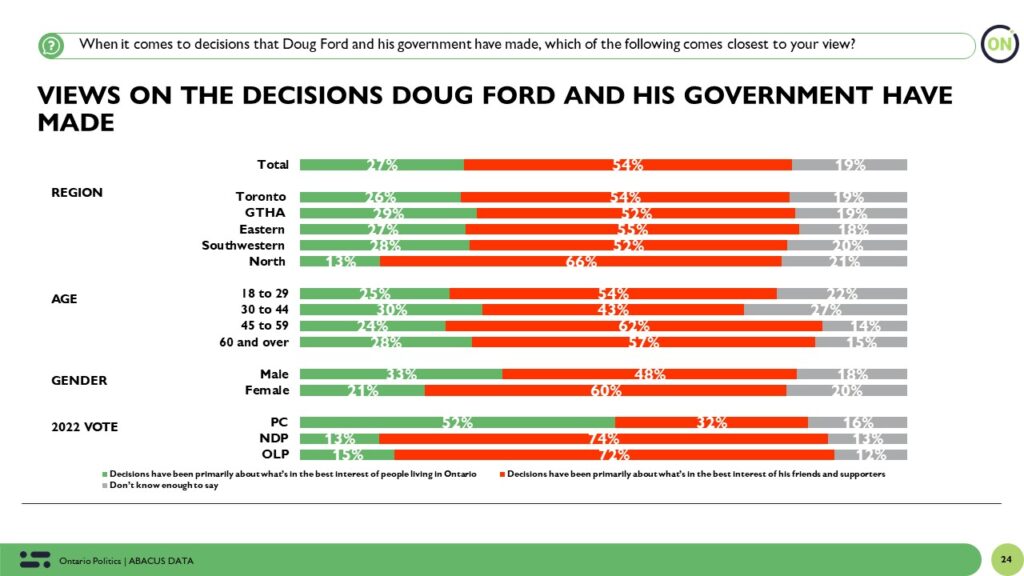
The Upshot
Doug Ford and the PCs remain in a solid position. Since last month, their lead over the opposition parties has grown, despite some frustration over the government’s handling of some important issues – maining affordability and housing.
The Ford government could be vulnerable on criticism that it’s decisions are motivated by a desire to help friends rather than what’s in the best interest of the public. We will see whether this sticks.
But ultimately, for the PCs to lose, voters who cast a ballot for a PC candidate have to switch their support. We aren’t seeing much evidence of that happening, frankly becauses voters don’t see any of the alternatives right now as viable. As the Ontario Liberal leadership race unfolds and voters get to know Marit Stiles more that could change, but right now, Doug Ford remains in the drivers seat.
Methodology
The survey was conducted with 1,000 adults living in Ontario adults from July 20 to 25, 2023. A random sample of panelists were invited to complete the survey from a set of partner panels based on the Lucid exchange platform. These partners are typically double opt-in survey panels, blended to manage out potential skews in the data from a single source.
The margin of error for a comparable probability-based random sample of the same size is +/- 3.1%, 19 times out of 20.
The data were weighted according to census data to ensure that the sample matched Ontario’s population according to age, gender, educational attainment, and region. Totals may not add up to 100 due to rounding.
This survey was paid for by Abacus Data Inc.
Abacus Data follows the CRIC Public Opinion Research Standards and Disclosure Requirements that can be found here: https://canadianresearchinsightscouncil.ca/standards/
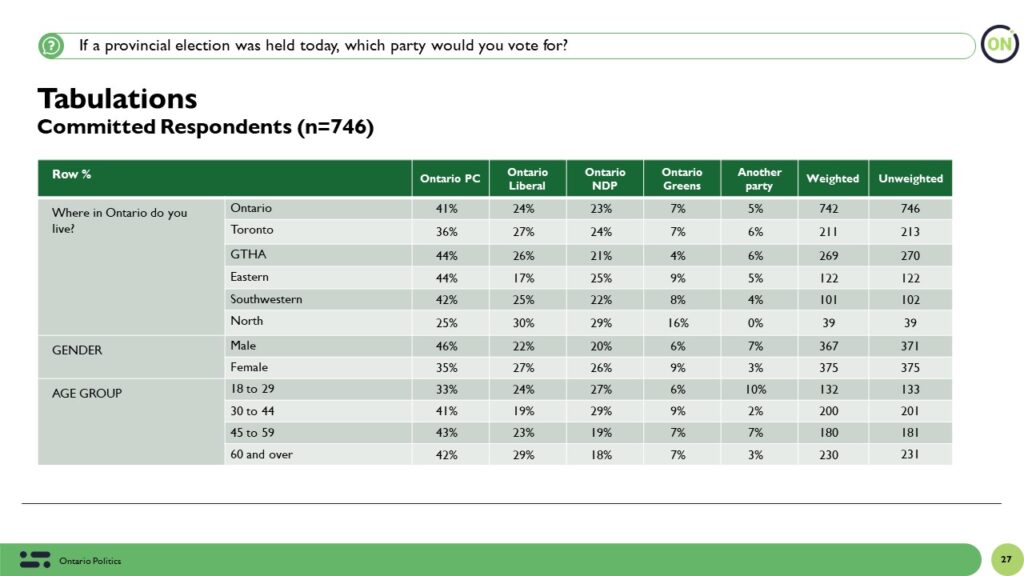
From July 20 to 25, 2023, Abacus Data conducted a national survey of 2,486 adults exploring several topics related to Canadian politics and current events as part of our regular national omnibus surveys. In this survey, we oversample Ontario to a total of 1,004 and Atlantic Canada to 435 .
As the Prime Minister is set to substantially shuffle the Cabinet this morning, the Conservatives have opened up a 10-point lead over the Liberals – 38% to 28% – with the NDP in third at 18%
Since the end up June, the Conservative vote share is up 4, the Liberals are down marginally by 1 while the NDP is down 2.


Regionally, the Conservatives are well ahead in BC, Alberta, and in Saskatchewan and Manitoba. Poilievre’s Conservatives lead by 6 in Ontario and are tied with the Liberals in Atlantic Canada. Note, we oversampled Atlantic Canada to get a better sense of things in that region and the once Liberal advantage on the east coast seems to be at risk.

The Liberals trail the Conservatives across all age groups, including those under 30. The Conservatives have a 14-point lead among men and a 4-point lead among women.


A few other key finds from the survey:
The federal government’s approval rating is down slightly from the end of June – 32% approve while 51% disapprove. 32% is the lowest approval score we’ve measured since July 2021.
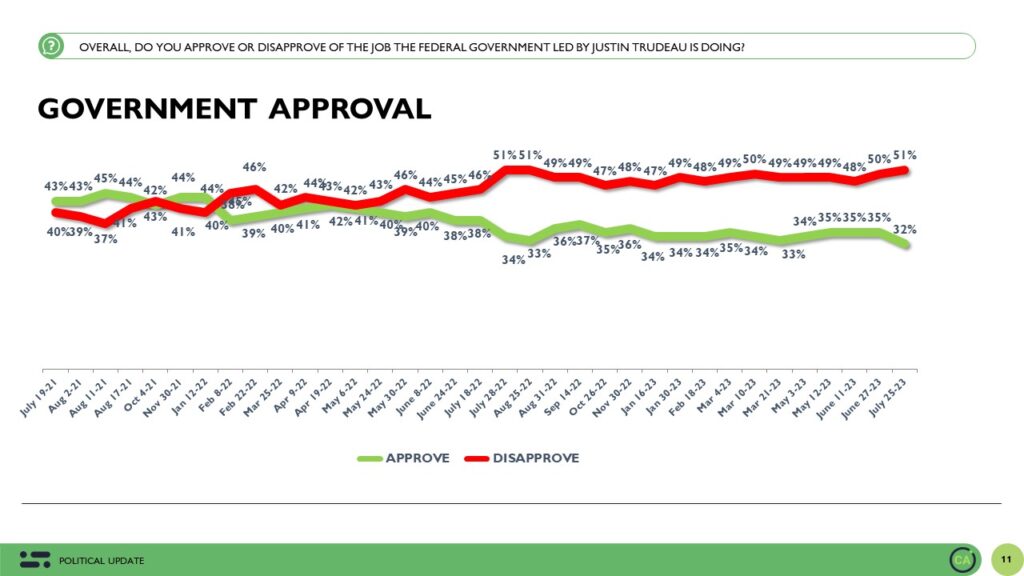
Impressions of the federal leaders are consistent with what we found at the end of June. Justin Trudeau is at -22 (29% positive vs. 51% negative), Pierre Poilievre is -6 (31% positive vs. 37% negative), while Jagmeet Singh is +5 (36% positive vs. 31% negative).

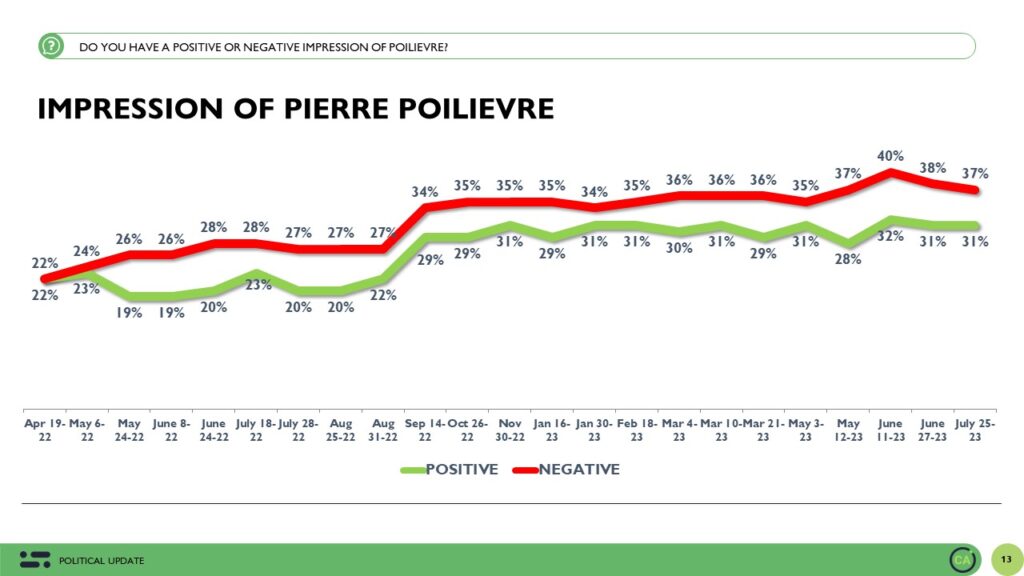
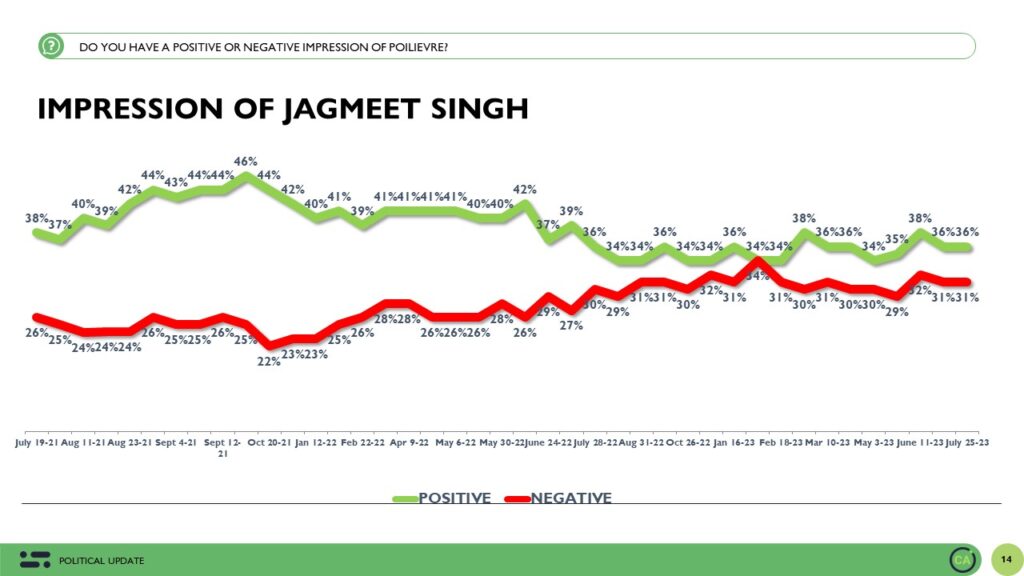
About half of Canadians want a change in government and feel there are good alternatives to the Liberals. This is up 3 since the end of June. 19% say they think the Liberals deserve to be re-elected, down 2. The remaining 31% say they think its time for a change, but don’t feel there’s a good alternative.
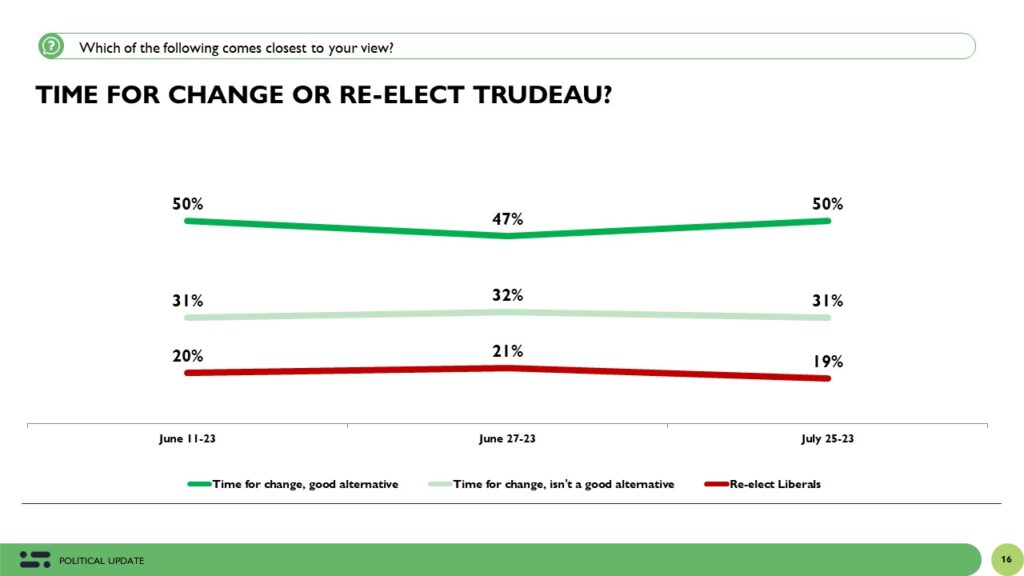
Among those who think it’s time for a change and think there’s a good alternative, 59% are voting Conservative and 21% are voting NDP. The Conservative share among this group is up 4 since June while the NDP share is done 3. The Conservatives may be consolidating the “change” vote.
Among those who think it’s time for a change but don’t think there’s a good alternative, the Liberal vote share is up, 33% would vote Liberal (+4), 23% would vote Conservative, 19% would vote NDP and 15% would vote BQ.
Among those who think the Liberals and Trudeau deserve to be re-elected, the Liberals get 78% of committed voters compared with 11% for the NDP and 3% for the Conservative.
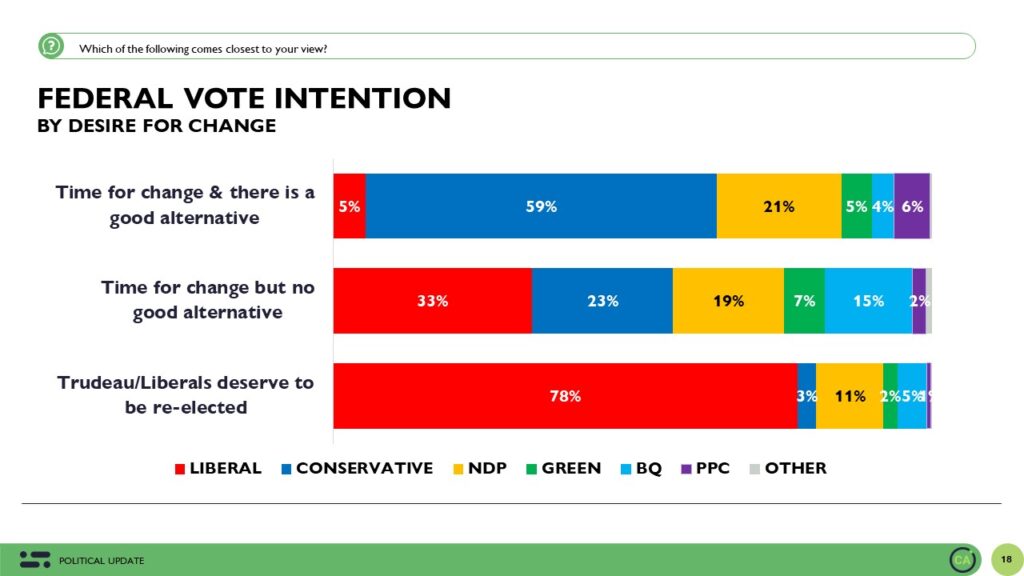
The top issues of concern are largely unchanged from last month. 72% rate the cost of living as a top 3 issue, followed by healthcare (down 3), housing affordability, the economy, and climate change. Of note, those putting climate change in their top 3 has increased by several points over the past few months.
Also of note, 14% put immigration in their top 3 issues, up 3 points since the end of June.

The Upshot
According to Abacus Data Chair & CEO: Despite vote share gains in some recent by-elections, the national picture remains quite challenging for the federal Liberals and Prime Minister Trudeau.
Only 19% think the government deserves to be re-elected. They trail the Conservatives by 10 points nationally having lost their advantage in Atlantic Canada, likely losing their lead in Ontario, and trailing the Conservatives badly in BC. In the Greater Toronto and Hamilton region in Ontario, the Conservatives lead by 12 in this latest poll.
The Prime Minister’s negatives remain elevated all while the cost of living, healthcare, and housing are in focus for most Canadians.
Today’s cabinet shuffle needs to signal that the government is responding to these concerns and the government should relentlessly focus on those issues.
For the Conservatives, while these results might feel good, there’s evidence that neither Poilievre or the party as a whole is making much progress comforting Canadians with the idea of a future Conservative, Poilievre-led government. This remains a real and present danger for the Conservatives.
1 in 3 Canadians continue to say they want change but don’t feel comfortable with the alternatives. The Conservatives have actually lost ground among this group. Poilievre’s personal numbers haven’t moved and remain better than the Prime Minister’s but many still don’t have a firm sense of him or what he stands for – more to come on that front shortly.
METHODOLOGY
The survey was conducted with 2,486 Canadian adults from July 20 to 25, 2023. A random sample of panelists were invited to complete the survey from a set of partner panels based on the Lucid exchange platform. These partners are typically double opt-in survey panels, blended to manage out potential skews in the data from a single source.
The margin of error for a comparable probability-based random sample of the same size is +/- 2.0%, 19 times out of 20.
The data were weighted according to census data to ensure that the sample matched Canada’s population according to age, gender, educational attainment, and region. Totals may not add up to 100 due to rounding.
This survey was paid for by Abacus Data Inc.
Abacus Data follows the CRIC Public Opinion Research Standards and Disclosure Requirements that can be found here: https://canadianresearchinsightscouncil.ca/standards/
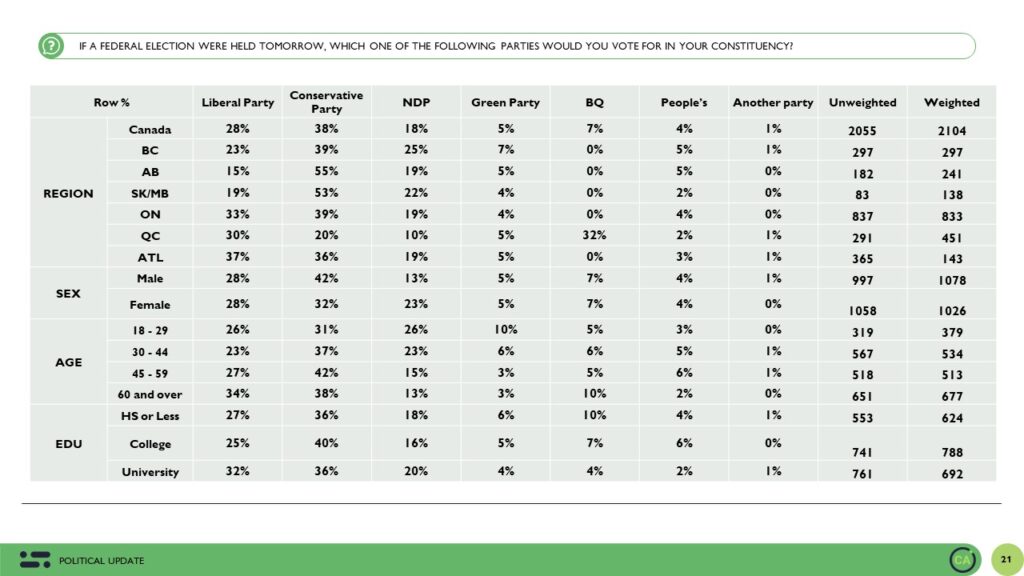
ABOUT ABACUS DATA
We are the only research and strategy firm that helps organizations respond to the disruptive risks and opportunities in a world where demographics and technology are changing more quickly than ever.
We are an innovative, fast-growing public opinion and marketing research consultancy. We use the latest technology, sound science, and deep experience to generate top-flight research-based advice to our clients. We offer global research capacity with a strong focus on customer service, attention to detail, and exceptional value.
We were one of the most accurate pollsters conducting research during the 2021 Canadian election following up on our outstanding record in 2019.
Contact us with any questions.
Find out more about how we can help your organization by downloading our corporate profile and service offering.
An overwhelming majority (71%) of Canadians support the federal government’s forthcoming Clean Electricity Regulations—designed to ensure that Canada’s electricity grid is 100% clean by 2035—finds a new poll from Clean Energy Canada and Abacus Data.
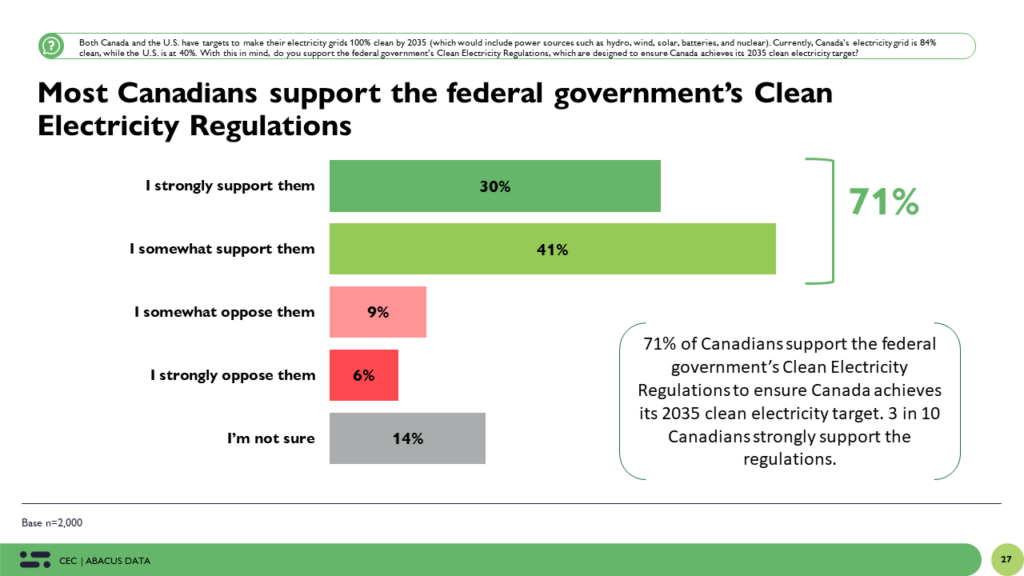
In B.C. and Atlantic Canada, support for the Clean Electricity Regulations is even higher, with nearly 8 in 10 saying that they “somewhat” or “strongly” support them. More Canadians support the regulations than are against them in every region, including Alberta.
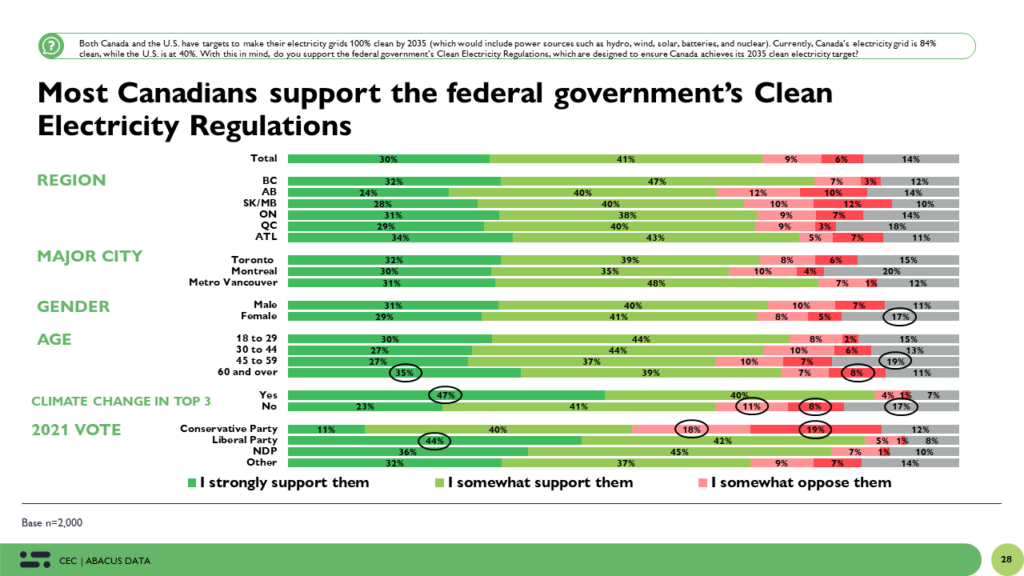
When asked to rate arguments for why Canada should transition to 100% clean electricity, Canadians rate “clean electricity is necessary to combat climate change” as the most convincing. Also convincing, they find, are the arguments that “clean electricity is more secure than fossil fuel electricity” and that “Canada already has one of the cleanest electricity grids in the world and is well-positioned to set an example for other countries.”
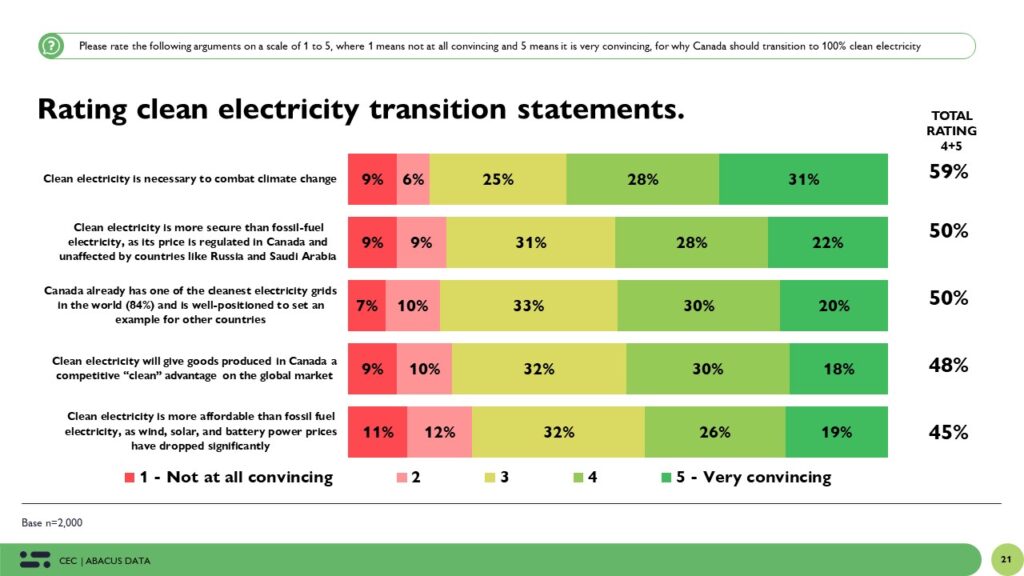
QUOTE
Evan Pivnick, clean energy program manager at Clean Energy Canada
“Clean power is the backbone of a successful energy transition. It’s what powers our homes, our cars, and businesses in a net-zero Canada. And it’s very popular. While Alberta’s premier has positioned herself against Canada’s forthcoming Clean Electricity Regulations, the fact is that a majority of Albertans actually support the policy, and the province is poised to be a leader in securing clean energy investments. Clean electricity is a climate imperative, an economic advantage, and a no-brainer for Canada. We already have one of the world’s cleanest power grids—wasting that head start is no way to win a race.”
METHODOLOGY
The survey was conducted with 2,000 Canadian adults from June 06 to 11, 2023. A random sample of panelists were invited to complete the survey from a set of partner panels based on the Lucid exchange platform. These partners are typically double opt-in survey panels, blended to manage out potential skews in the data from a single source. The margin of error for a comparable probability-based random sample of the same size is +/- 2.191%, 19 times out of 20. The data were weighted according to census data to ensure that the sample matched Canada’s population according to age, gender, educational attainment, and region. Totals may not add up to 100 due to rounding.
ABOUT ABACUS DATA
We are the only research and strategy firm that helps organizations respond to the disruptive risks and opportunities in a world where demographics and technology are changing more quickly than ever.
We are an innovative, fast-growing public opinion and marketing research consultancy. We use the latest technology, sound science, and deep experience to generate top-flight research-based advice to our clients. We offer global research capacity with a strong focus on customer service, attention to detail, and exceptional value.
We were one of the most accurate pollsters conducting research during the 2021 Canadian election following up on our outstanding record in 2019.
Contact us with any questions.
Find out more about how we can help your organization by downloading our corporate profile and service offering.
In the last few years, states across America have advanced a record number of bills that attack LGBTQ rights and freedoms, especially for transgender youth. While not all of these bills will ultimately become law, they all cause harm to the LGBTQ2S+ community.
While LGBTQ2S+ Canadians are lucky to have some of the most extensive rights in the world, that doesn’t mean our fight is over just yet. Pride is as much about celebrating the LGBTQ2S+ community’s historic past as it is about paving the way for future generations to be afforded the same rights and freedoms as every other citizen, regardless of nationality. For that reason, rather than focusing on celebrations and historic triumphs, we wanted to understand exactly how the LGBTQ2S+ community is perceived in terms of their rights, respect, and acceptance in Canada.
Here’s what we found:
11% of Canadians (or just over 4.2 million Canadians) identify as a member of the LGBTQ2S+ community. This is relatively consistent across demographic groups, but differs by age. Those between the ages of 18 and 29 were significantly more likely than any other group to identify as a member of the LGBTQ2S+ community. This is most likely due to the relatively recent acceptance of the community and the fact that when others see people like them being accepted into society, they are more likely to openly be their true selves.
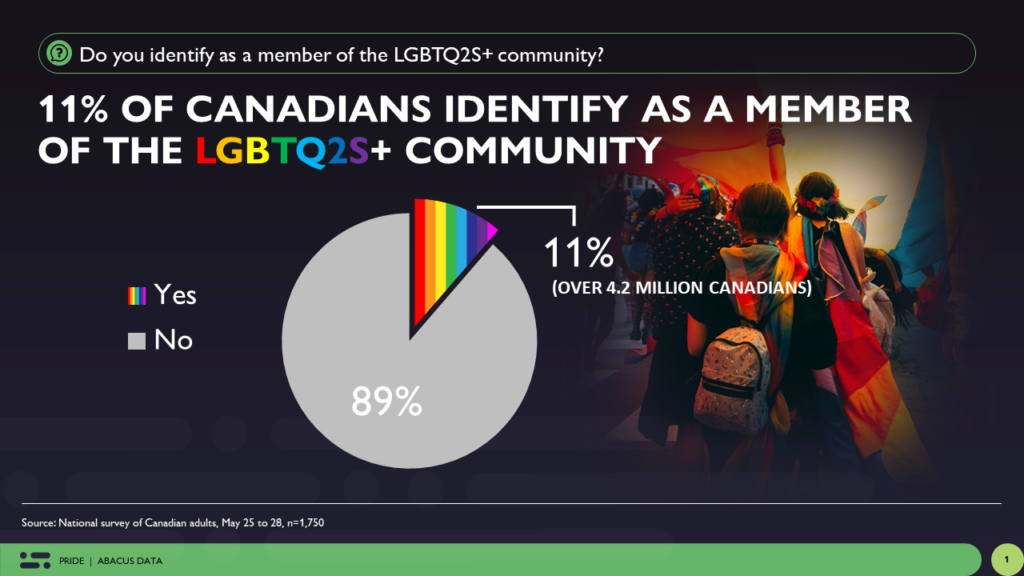
When asked about the current state of LGBTQ2S+ rights, respect, and acceptance in Canada, it is evident that Canadians may be overly optimistic about some of the realities this community faces. While 55% of those not in the LGBTQ2S+ community believe that the community has all of the same rights and freedoms as every other Canadian, only 38% of those who identify as part of the LGBTQ2S+ community agree.
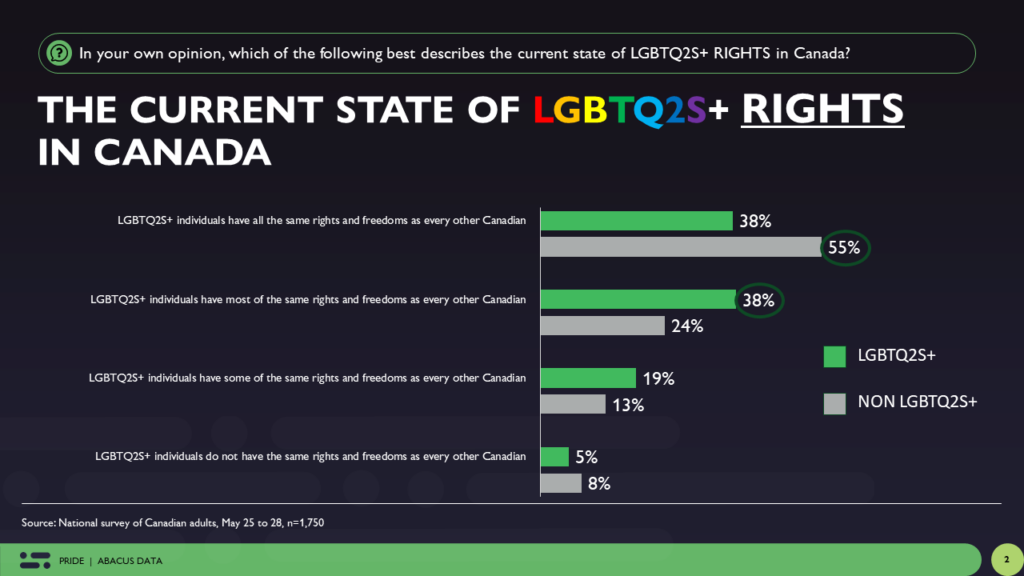
Furthermore, when asked whether or not Canada was moving in the right or wrong direction regarding LGBTQ2S+ rights, those not in the community are significantly more likely to say that we are moving in the wrong direction. With so many LGBTQ2S+ individuals feeling that Canada is headed in the right direction regarding their rights and freedoms, this could very well point towards a divide on the issue. While more research is needed to be certain, it may be the case that a sizeable group of Canadians is not supportive of the LGBTQ2S+ community being afforded all of the same rights and freedoms as every other Canadian.

In terms of how LGBTQ2S+ rights are respected in Canada, both groups are relatively consistent in their views. That being said, non-LGBTQ2S+ individuals were 6-points more likely to say that LGBTQ2S+ rights are fully respected and honoured in Canada while the LGBTQ2S+ community are 8-points more likely to feel that their rights are only mostly respected and honoured. Again, these differing views, while minor, point towards an overly optimistic view from those who do not identify as a member of the LGBTQ2S+ community.

Interestingly, Canadians from both groups are also quite consistent in their views regarding LGBTQ2S+ acceptance in Canada. Identical proportions from each group feel that individuals are fully accepted and celebrated in Canada, with every other category receiving a 3-point difference or less. While views may be consistent between groups, it is evident that the outlook is not a positive one. In fact, 4 in 10 Canadians believe that LGBTQ2S+ individuals face challenges to their acceptance in Canada.

While remaining optimistic is rarely a negative thing, being overly optimistic in the face of disparity can present a major barrier to progress. While it may be commonly believed that LGBTQ2S+ individuals are respected and accepted in Canada, in reality, they are nearly twice as likely to rate their overall happiness at or below a three out of ten.

Furthermore, LGBTQ2S+ individuals are significantly more likely to feel that they have not achieved as much in life as they thought they would by now. Given the gap in those who agree, it is evident that the LGBTQ2S+ community is likely not being presented with the same opportunities, support systems, and resources as every other Canadian.

And to make matters worse, our survey finds that LGBTQ2S+ Canadians are over 4x more likely to have faced discrimination as a direct result of their gender, sexual identity, sexual attraction, or sexual orientation. So, while it may be nice to believe that our LGBTQ2S+ community is respected, accepted, and celebrated in Canada, understanding that there is still major room for improvement is a fundamental component to establishing the positive changes we still need to make.

UPSHOT
Pride is as much about celebrating the LGBTQ2S+ community’s historic past as it is about paving the way for future generations to be afforded the same rights and freedoms as every other citizen, regardless of nationality. While Canada has made tremendous strides on paper, at the end of the day, there needs to be greater recognition amongst the general public that we need to continue to work towards equality and that everyone needs to do their part to respect and honour the LGBTQ2S+ community’s rights and freedoms in our nation. And, as our neighbours to the south continue to advance bills attacking LGBTQ2S+ rights and freedoms, it is more important than ever to stand with the LGBTQ2S+ community not only during times of celebration but also when your support and acceptance are needed most.
METHODOLOGY
The survey was conducted with 1,750 Canadian adults from May 25 to 29, 2023. A random sample of panelists were invited to complete the survey from a set of partner panels based on the Lucid exchange platform. These partners are typically double opt-in survey panels, blended to manage out potential skews in the data from a single source.
The margin of error for a comparable probability-based random sample of the same size is +/- 2.343%, 19 times out of 20. The data were weighted according to census data to ensure that the sample matched Canada’s population according to age, gender, educational attainment, and region.
Totals may not add up to 100 due to rounding.
ABOUT ABACUS DATA
We are the only research and strategy firm that helps organizations respond to the disruptive risks and opportunities in a world where demographics and technology are changing more quickly than ever.
We are an innovative, fast-growing public opinion and marketing research consultancy. We use the latest technology, sound science, and deep experience to generate top-flight research-based advice to our clients. We offer global research capacity with a strong focus on customer service, attention to detail, and exceptional value.
We were one of the most accurate pollsters conducting research during the 2021 Canadian election following up on our outstanding record in 2019.
Contact us with any questions.
Find out more about how we can help your organization by downloading our corporate profile and service offering.
VANCOUVER – A large majority (68%) of Canadians believe that Canada’s recent wildfires are “definitely” or “most likely” at least partly the result of climate change, according to a new survey from Clean Energy Canada and Abacus Data.
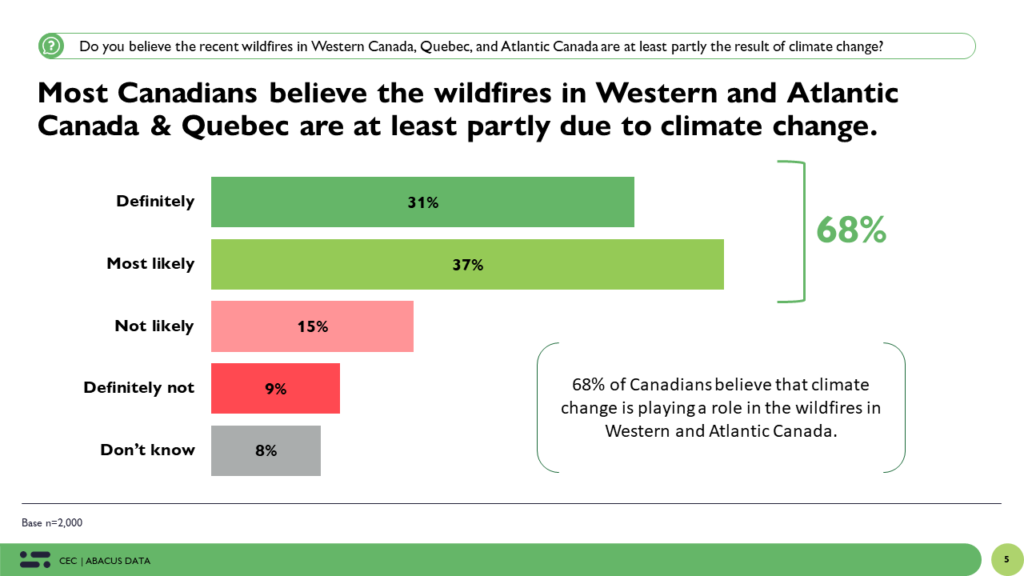
Additionally, nearly all (89%) Canadians say they have noticed an increase in natural disasters over the past decade, with seven in 10 believing that this is a direct effect of climate change. Only 12% say they haven’t noticed an increase in natural disasters, while another 18% have observed an increase but believe it is “just a coincidence, not climate change.”

When asked to rate how fast Canada is moving on investing in and transitioning to clean energy, more than half (56%) of Canadians think that Canada is moving “fairly slowly” or “very slowly,” while less than half (49%) say the same of our allies. On both fronts, Canadians are somewhat pessimistic about the pace of the energy transition.
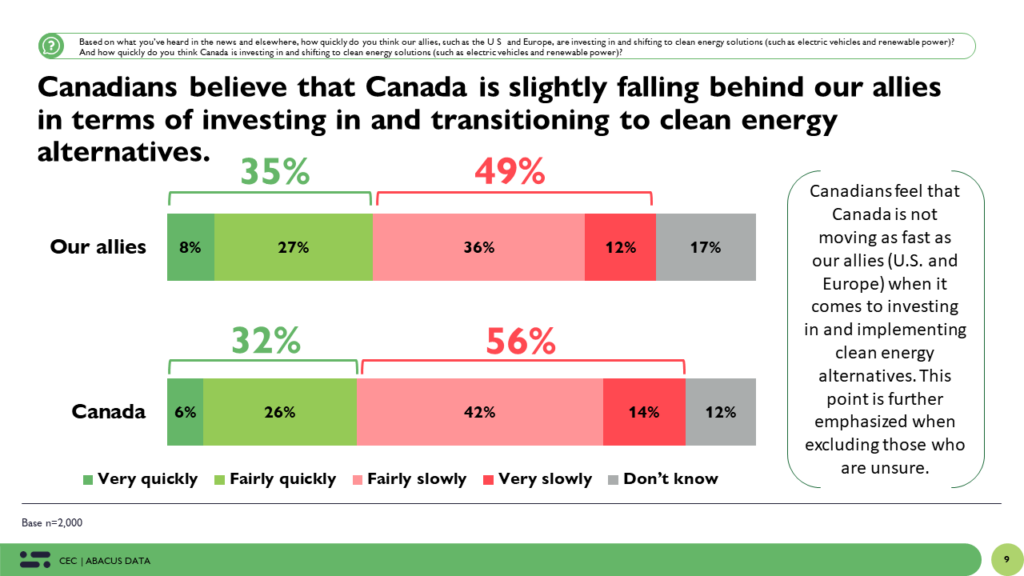
Meanwhile, nearly all (87%) Canadians feel that it is “very important” or “somewhat important” for federal and provincial governments to ensure that Canada remains competitive with our allies and trading partners when it comes to growing our clean energy sector and sustainably produced exports.
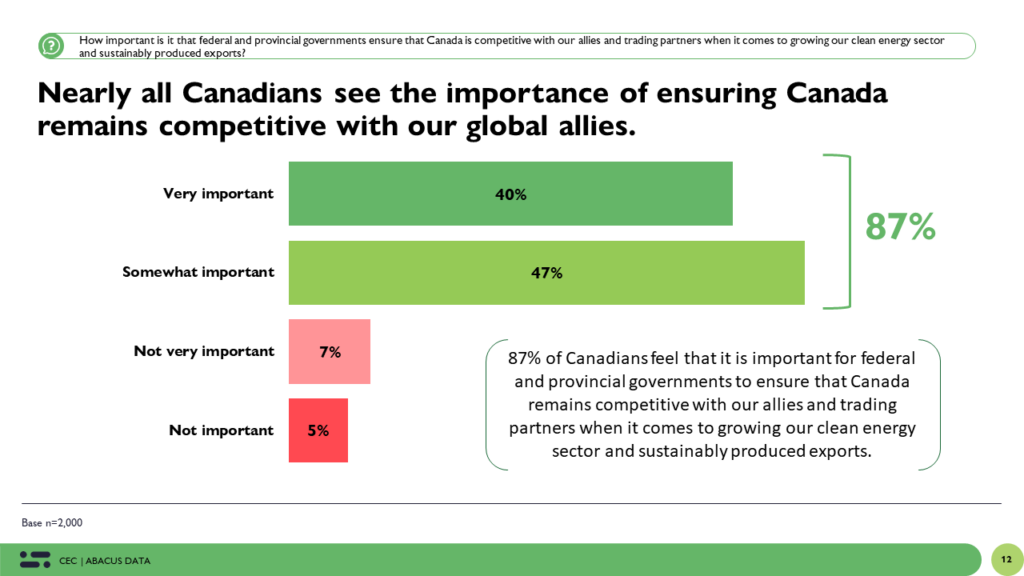
While roughly half (47%) of Canadians saw the recent electric vehicle and battery manufacturing announcements in Canada, 68% say that they view them as evidence that the transition to clean energy can benefit Canada’s economy and job creation. Younger Canadians were much more likely to see the announcements as beneficial.
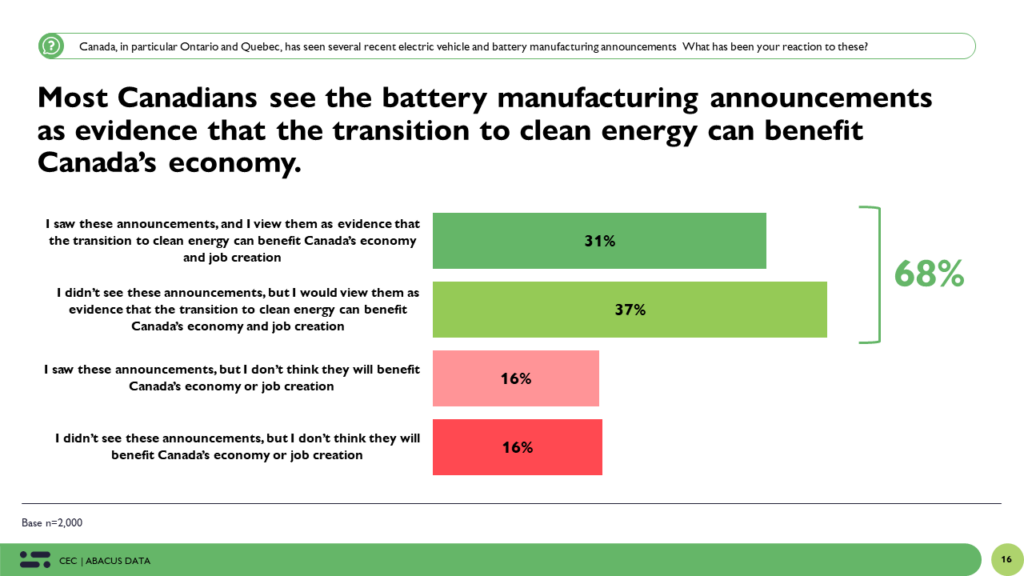
Thinking about the next federal election, nearly all (86%) Canadians expressed that having a good plan for addressing climate change and growing Canada’s clean economy will impact their vote, with nearly 6 in 10 deeming it as “essential” or “very important” for their vote.

Finally, many Canadians are still getting their information through the news. When asked how they determine whether a political party has a good plan to address climate change and grow Canada’s clean economy, roughly half (49%) say they “read or watch the news,” while 33% say they “listen to the experts.” Only 16% cite social media as a source of information.

QUOTES
Trevor Melanson, communications director at Clean Energy Canada
“As the impacts of climate change become more frequent and apparent, Canadians are connecting the dots. They’re also connecting the economic dots, with a strong majority seeing recent EV and battery manufacturing announcements as evidence that the clean energy transition can drive growth and job creation. For politicians, this is more than a box to tick. Canadians both care deeply about climate action and are generally skeptical of political parties on this issue. It will take serious, sustained, and credible efforts to win them over.”
David Coletto, CEO at Abacus Data
“Wildfires and extreme weather remind Canadians that climate change isn’t just a global or theoretical phenomenon. It is having real and often devastating impacts on people’s lives. The result is that a growing number of people are making a party or political leader’s commitment to tackling the crisis table stakes to their political behaviour.”
METHODOLOGY
The survey was conducted with 2,000 Canadian adults from June 06 to 11, 2023. A random sample of panelists were invited to complete the survey from a set of partner panels based on the Lucid exchange platform. These partners are typically double opt-in survey panels, blended to manage out potential skews in the data from a single source.
The margin of error for a comparable probability-based random sample of the same size is +/- 2.2%, 19 times out of 20. The data were weighted according to census data to ensure that the sample matched Canada’s population according to age, gender, educational attainment, and region.
Totals may not add up to 100 due to rounding.
ABOUT ABACUS DATA
We are the only research and strategy firm that helps organizations respond to the disruptive risks and opportunities in a world where demographics and technology are changing more quickly than ever.
We are an innovative, fast-growing public opinion and marketing research consultancy. We use the latest technology, sound science, and deep experience to generate top-flight research-based advice to our clients. We offer global research capacity with a strong focus on customer service, attention to detail, and exceptional value.
We were one of the most accurate pollsters conducting research during the 2021 Canadian election following up on our outstanding record in 2019.
Contact us with any questions.
Find out more about how we can help your organization by downloading our corporate profile and service offering.
Last week, we released a new poll commissioned by Oceans North that found broad support for Canada to invest in zero-emission ports, marine vessels, and trade routes, with more than 3 in 4 Canadians reporting high concern about climate change. The sample size was 1,750 adult Canadians and the survey was conducted from May 25 to 29, 2023.
Today we are releasing the final part of the survey, which finds Canadians are far more likely to think maritime shipping should move entirely to a zero-emission fuel like hydrogen rather than use liquified natural gas to power ships.
In the survey, we told respondents:
“Right now, there is a debate about whether the shipping industry should use liquefied natural gas (LNG) to power ships, which could partially reduce but not eliminate emissions, or whether the sector should transition entirely to zero-emission fuels.”
And asked, “which of the following approaches do you think is best?”
Overall, 61% of Canadians preferred a move entirely to zero-emission fuel like hydrogen while 39% preferred using LNG to power ships.
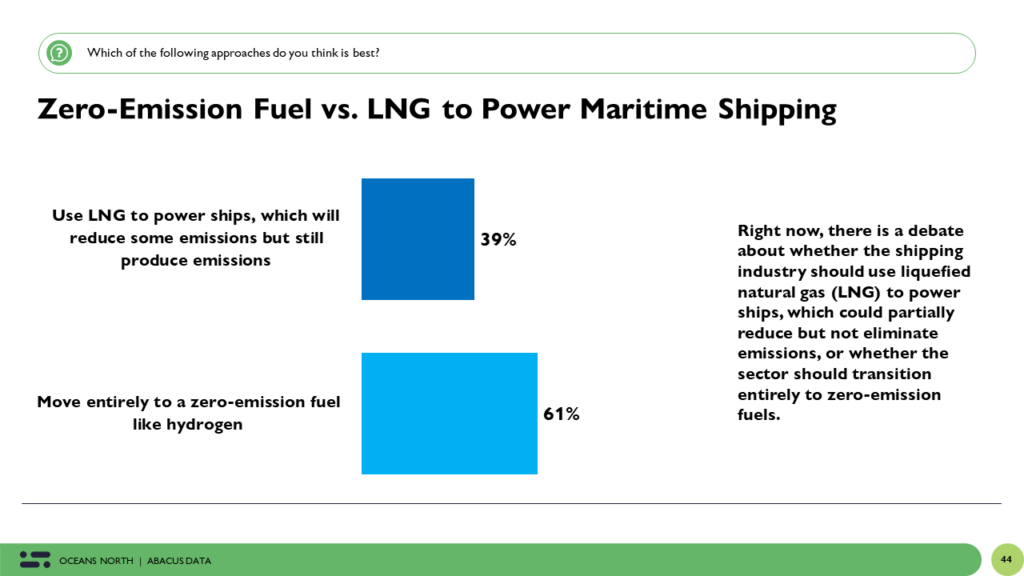
Regionally, support for zero-emission fuels was higher in Quebec (69%), Ontario (63%), and Atlantic Canada (61%). Alberta was the only province where more people preferred LNG over a zero-emission fuel.
Those under 30 were much more likely to prefer a zero-emission fuel than LNG (71% to 29%) while older Canadians were slightly more divided, although a majority still preferred a zero-emission fuel.
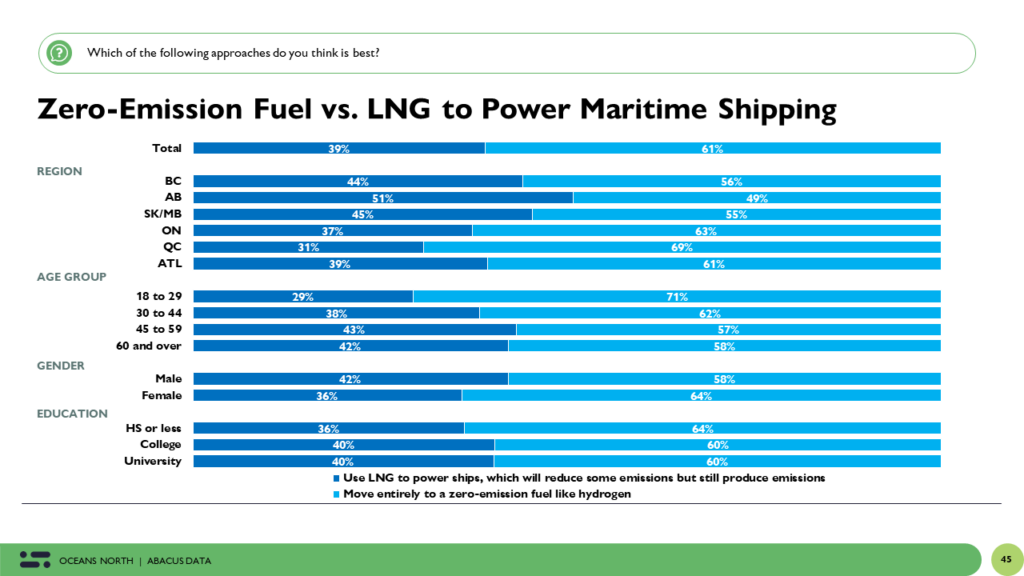
There is a strong relationship between concern for climate change and preferred approach to marine shipping fuel. Those who are more intensely concerned about climate change are more likely to prefer a zero-emission fuel over LNG.
Politically, clear majorities of Liberal and NDP supporters prefer a zero-emission fuel while a majority of Conservative supporters prefer LNG.
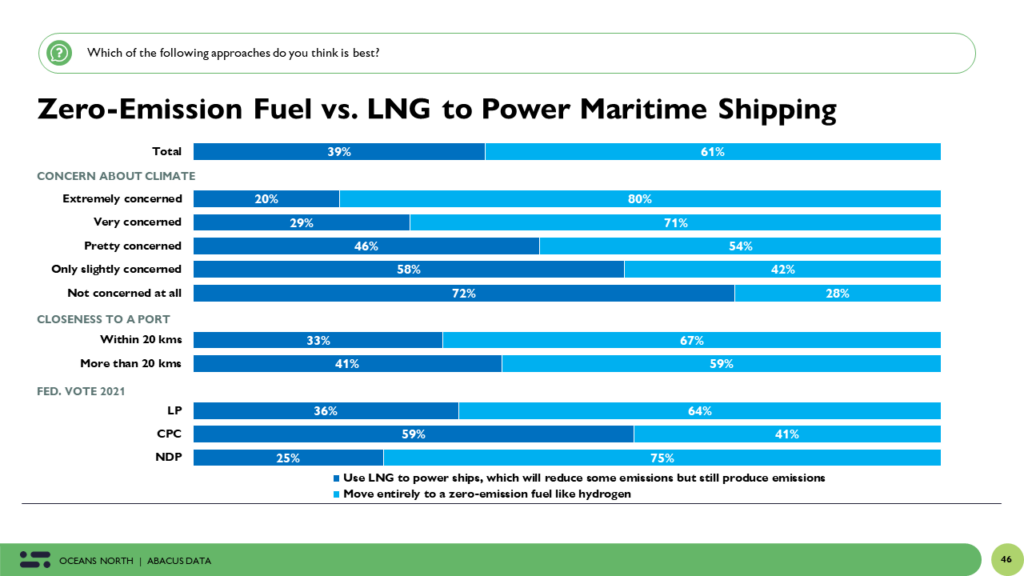
THE UPSHOT
As concern about climate change intensifies, and I suspect it will as extreme weather, wildfires, and drought increase in both frequency and intensity, support for a quicker energy transition will increase.
How we fuel maritime shipping is a case in point. In this survey, more Canadians want the sector to transition entirely to a zero-emission fuel rather than using liquified natural gas. There is a strong relationship between one’s concern about climate change and their response this question.
METHODOLOGY
The survey, commissioned by Oceans North, was conducted online with 1,750 Canadians aged 18 and over from May 25 to 29, 2023.
A random sample of panelists were invited to complete the survey from a set of partner panels based on the Lucid exchange platform. These partners are typically double opt-in survey panels, blended to manage out potential skews in the data from a single source.
The margin of error for a comparable probability-based random sample of the same size is +/- 2.2%, 19 times out of 20.
The data were weighted according to census data to ensure that the sample matched Canada’s population according to age, gender, educational attainment, and region. Totals may not add up to 100 due to rounding.
OCEANS NORTH
Oceans North is a charitable organization that supports marine conservation and climate action in partnership with Indigenous and coastal communities. As part of a holistic strategy to protect the ocean, Oceans North is working to decarbonize maritime emissions that are contributing to climate change and adversely impacting communities and the environment. For more information, contact Alex Tesar at atesar@oceansnorth.ca or visit https://www.oceansnorth.org/en/what-we-do/the-zero-emission-maritime-energy-transition/.
ABOUT ABACUS DATA
We are the only research and strategy firm that helps organizations respond to the disruptive risks and opportunities in a world where demographics and technology are changing more quickly than ever.
We are an innovative, fast-growing public opinion and marketing research consultancy. We use the latest technology, sound science, and deep experience to generate top-flight research-based advice to our clients. We offer global research capacity with a strong focus on customer service, attention to detail, and exceptional value.
We were one of the most accurate pollsters conducting research during the 2021 Canadian election following up on our outstanding record in 2019.
Contact us with any questions.
Find out more about how we can help your organization by downloading our corporate profile and service offering.